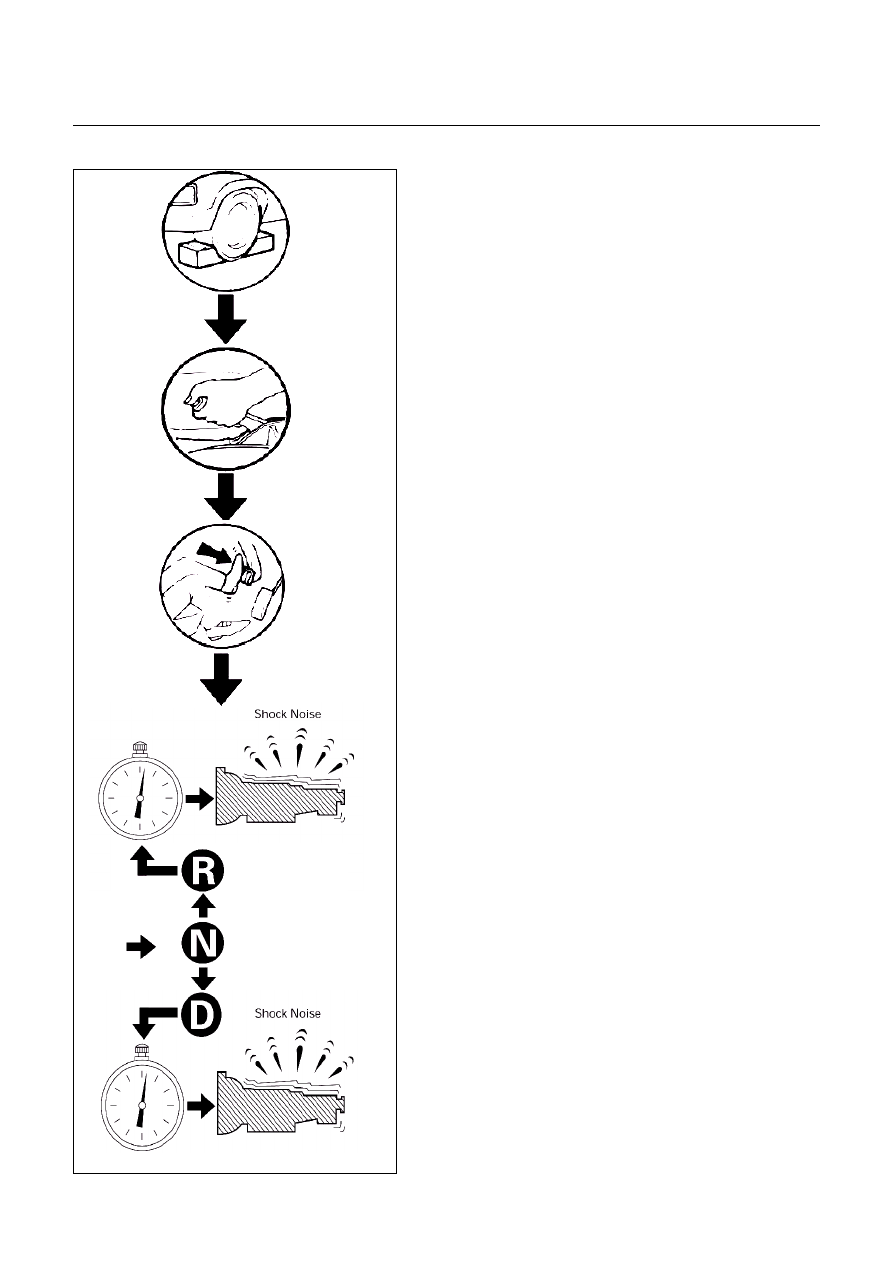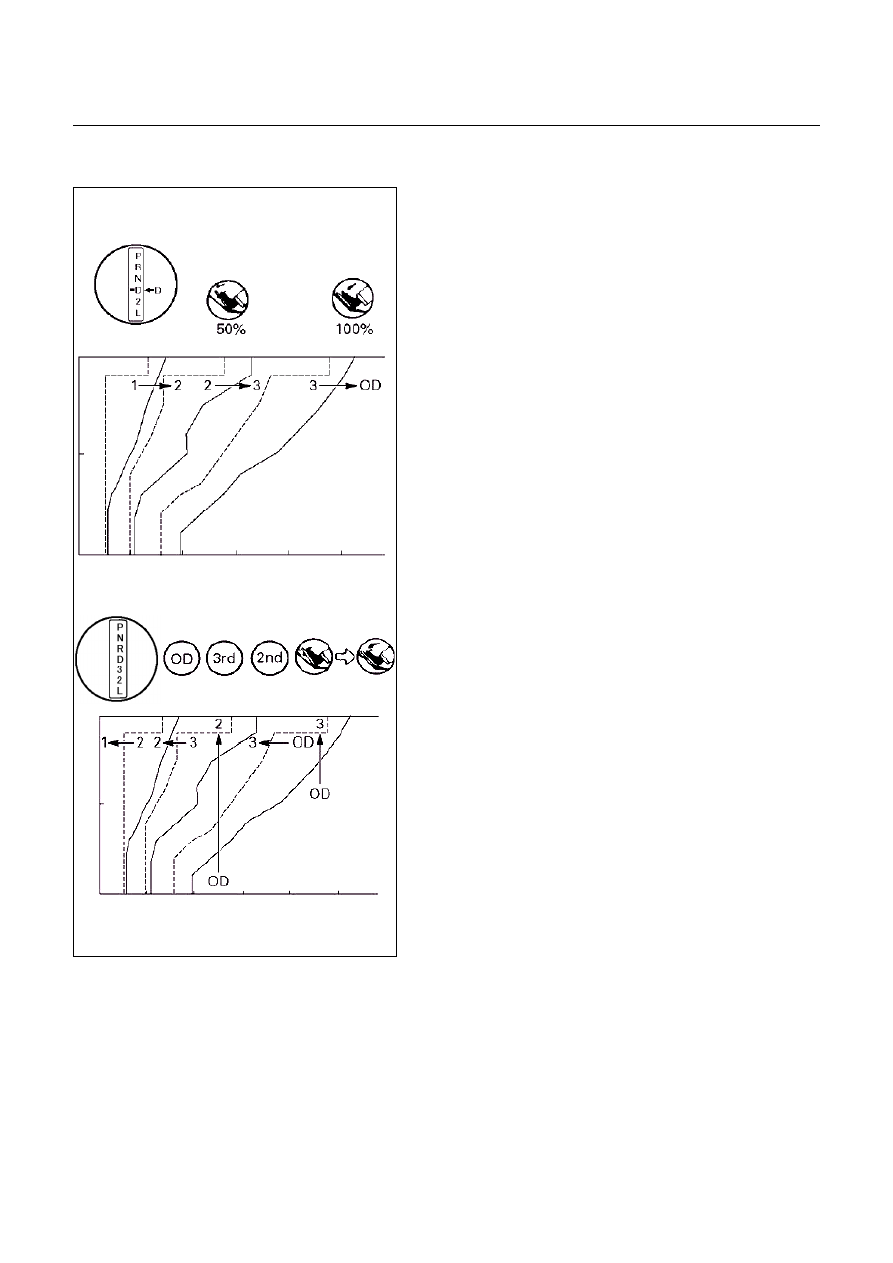Isuzu D-Max / Isuzu Rodeo (TFR/TFS). Manual — part 1882

DIAGNOSIS 7A2-144
4. If the line pressure is lower than standard value at
idling in L and R ranges.
•
ATF leaking from low and reverse brake hydraulic
circuit.
5.
If the line pressure is higher than standard value at
idling in all ranges.
•
Throttle opening signal reception error.
•
Faulty oil temperature sensor.
•
Faulty operation of low clutch solenoid.
•
Sticking pilot valve.
•
Sticking pressure regulator valve or plug.
6.
If the line pressure is lower than standard value at stall
speed in all ranges.
•
Throttle opening signal reception error.
•
Faulty operation of line pressure solenoid.
•
Faulty operation of low clutch solenoid.
•
Sticking pilot valve.
•
Sticking pressure regulator valve or plug.

DIAGNOSIS 7A2-145
TIME LAG TEST
Procedure
1.
Chock the four wheels.
2.
Warm up the engine.
3.
Apply the parking brake.
4.
Step on the foot brake fully.
5.
Set the select lever from N to D or N to R range.
6.
Record the time from when moving the select button until
feeling shock.
Time Lag
Standard:
N to D Range: Below 0.7 Seconds
N to R Range: Below 1.2 Seconds
Evaluation
1.
If the time lag is out of standard value when shifting N
to D range.
•
Forward range line pressure is low.
•
Slip of low clutch.
•
Slip of low one-way clutch.
•
Trouble in control valve body (faulty operation, sticking,
clogged oil passage).
•
Faulty low clutch duty solenoid operation.
•
Shortage or faulty quality of ATF.
2.
If the time lag is out of standard value when shifting N
to R range.
•
Reverse range line pressure is low.
•
Slip of low & reverse brake.
•
Slip of reverse clutch.
•
Trouble in control valve body (faulty operation, sticking,
clogged oil passage).
•
Faulty low & reverse brake duty solenoid operation.
•
Shortage or faulty quality of ATF.

DIAGNOSIS 7A2-146
TEST DRIVE
NOTE:
Perform the test at normal operation ATF temperature 50 -
80
°°°°
C.
Drive the vehicle on level ground so as not to change to
up and down hill control.
1.
D range test in Normal and Power shift pattern.
1)
Shift into the D range and hold the accelerator pedal
constant at the 50% and 100% throttle angle.
2)
1-2, 2-3, 3-4 and lock-up, up-shift should take place, and
shift points should confirm to those shown in the
diagram.
3)
Also check to see that downshift is made from 4-3, 3-2
and 2-1 down-shift point is within the limits shown in the
diagram.
2.
3 range test in Normal and Power shift pattern.
1)
Shift into the 3 range and hold the accelerator pedal
constant at the 50% and 100% throttle angle.
2)
1-2, 2-3 and lock-up, up-shift should take place, and
shift points should confirm to those shown in the
diagram.
3)
While running in the 3 rages, does not up-shift 3-4.
4)
Also check to see that down-shift is made from 4-3, 3-2
and 2-1 down-shift point is within the limits shown in the
diagram.
3.
2 range test in Normal shift pattern.
1)
Shift into the 2 range and hold the accelerator pedal
constant at the 50% and 100% throttle angle.
2)
1-2 and up-shift should take place, and shift points
should confirm to those shown in the diagram.
3)
While running in the 2 rages, does not up-shift 2-3 or 3-
4, and lock-up does not operate.
4)
Also check to see that down-shift is made from 4-3, 3-2
and 2-1 down-shift point is within the limits shown in the
diagram.
4. L range test in Normal shift pattern.
1)
While running in the L rages, does not up-shift 1-2, 2-3
or 3-4, and lock-up does not operate.
2)
Also check to see that down-shift is made from 4-3, 3-2
and 2-1 down-shift point is within the limits shown in the
diagram.

DIAGNOSIS 7A2-147
5. R range test.
1)
Shift into the R range and while starting at full throttle,
check for slipping.
6.P range test.
1)
Stop the vehicle on a grade and after shifting into the P
range, release the parking brake. Then check to see that
the parking lock pawl holds the vehicle in place.
Select
Lever
Position
Gear
Position
Gear
Shift
P
R
Reverse
N
D
1st
2nd
3rd
4th
3
1st
2nd
3rd
4th(*1)
2
1st
2nd
3rd(*1)
4th(*1)
L
1st
2nd(*1)
3rd(*1)
4th(*1)
Evaluation
1.
If there is no 1 to 2 up-shift.
•
2-4 brake malfunction.
•
2-4 brake hydraulic circuit failed.
•
2-4 brake duty solenoid stick.
Refer to symptom diagnosis "No. D1: Faulty Gear
Shifting" or DTC section "Gear Ratio Error".
2.
If there is no 2 to 3 up-shift.
•
High clutch malfunction.
•
High clutch hydraulic circuit failed.
•
High clutch duty solenoid stick.
Refer to symptom diagnosis "No. D1: Faulty Gear
Shifting" or DTC section "Gear Ratio Error".
3.
If there is no 2 to 4 (O/D) up-shift.
•
2-4 brake malfunction.
•
2-4 brake hydraulic circuit failed.
•
2-4 brake duty solenoid stick.
Refer to symptom diagnosis "No. D1: Faulty Gear
Shifting" or DTC section "Gear Ratio Error".
4.
If there is no lock-up in 2, 3 and 4.
•
Lock-up piston malfunction.
•
Lock-up hydraulic circuit failed.
•
Lock-up duty solenoid stick.
Refer to symptom diagnosis "No. I1: No Lock-up" or
DTC section "Lock-up Duty Solenoid Failure".
*1: Transmission is shifted at high speed to
prevent engine over-run.

Нет комментариевНе стесняйтесь поделиться с нами вашим ценным мнением.
Текст